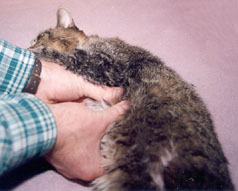- Clinical signs: Vomiting, diarrhea, hives, and difficulty breathing (often
manifested by panting or open-mouthed breathing as a dog would do). These
reactions may occur following vaccination or drug injections.
- Treatment:
- EPINEPHRINE (1:1000) Dilute 1 mL in 10 mLs of saline and give 0.5 mL per
10 lbs. IM. See page H205 for details on epinephrine.
- In severe cases, epinephrine can be given IV. If given IV,
administer slowly.
- ANTI-INFLAMMATORY - Dexamethasone, methylprednisolone, prednisolone, and
triamcinolone are often used. These are given IM, IV, or SQ, depending on
the product.
- Contact a veterinarian immediately.
- Bleeding
Bleeding can be slowed by utilizing many different methods:
- Apply direct pressure using clean towels, bandage material, and some
type of tape or wrap. These dressings, once soaked with blood, should not
be removed, but should be left on and additional layers placed over the
old ones.
- Keep the pet calm and confined.
- If the bleeding on a limb is extremely severe, a tourniquet may be
applied above the injury. A rubber band makes an effective tourniquet for
a catís leg. Caution should be taken to ensure that the tourniquet is
not left on for long periods of time.
- Contact a veterinarian immediately.
- Diarrhea - See page E155
- Newborn kittens that are not breathing
To stimulate respirations:
- Remove the mucous and membranes from the nose and mouth (a syringe or
bulb syringe can help).
- Rub the body briskly with a warm towel and stimulate the nose and
mouth.
- Place 1-3 drops of Dopram under the base of the tongue. This dose can
be repeated in 2-3 minutes if the kitten is still not breathing.
- It is NOT recommended to swing the kitten in the air or hang it upside
down. Swinging actually makes it harder for the kitten to breathe.
- Seizures -
See page E750
Unconsciousness (Giving CPR)
- Clinical signs: Recumbent (lying down), cold, pale gums, possibly not
breathing. Injuries may be evident if the cause of unconsciousness is a
traumatic event.
- Treatment: Find out if the cat is breathing and has a heart beat. Artificial
respiration and heart massage (i.e. CPR) must be initiated immediately if
the cat has no pulse and/or has stopped breathing.
To stimulate breathing:
- Remove any obstruction to the upper airway. This is done by reaching
inside the catís mouth, feeling for any abnormal object, and removing
it.
- Administer mouth to nose artificial respiration. The mouth of the cat
must be gently shut or be partially covered. Blow air into the catís
nose, then pause to observe if there is movement in the chest as the lungs
fill with air. Care should be taken not to overinflate the lungs. Recent
guidelines suggest rapid respirations (2 to 3 per second), should be given
simultaneously with cardiac massages.
To stimulate the heart (heart massage):
- Perform heart massage (compression). Lay the cat with its right side
down. Place the thumbs of both hands on one side of the chest, with the
fingers of each hand on the other (see Fig. 1). The best location for this
is right behind the catís elbows. Firmly compress the chest between the
fingers and thumb. These compressions should be given repeatedly at the
rate of 2 to 3 per second concurrently with artificial respirations.
If both breathing and heart have stopped:
- Administer simultaneous heart compressions and artificial
respirations at the rapid rate of 2-3 compressions and 2-3 respirations
per second. Continue this pattern until the heart begins to beat
and the cat breathes on its own.
- Contact a veterinarian immediately.
Figure 1

|
| Performing heart compressions |
|
- Vomiting -
See page E924
Weakness - See page E948

